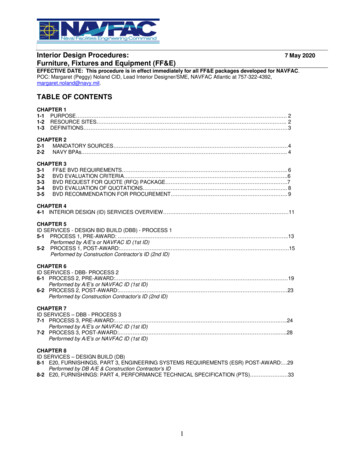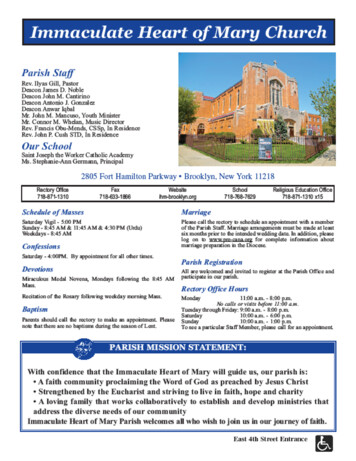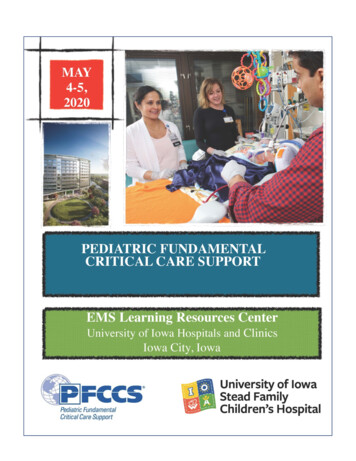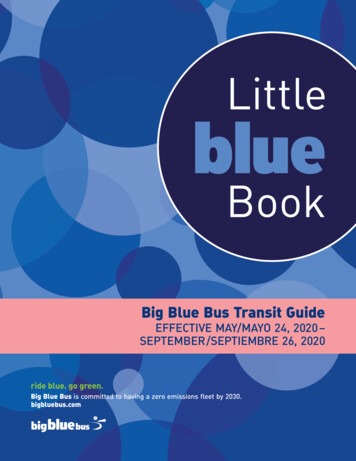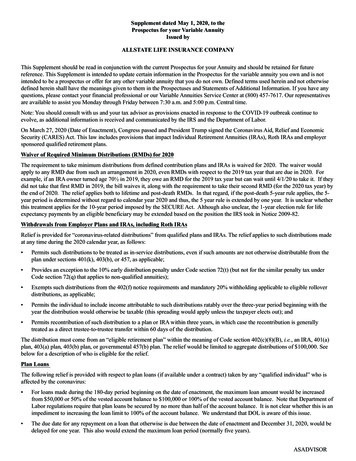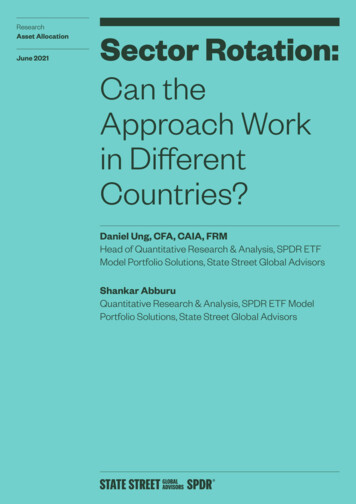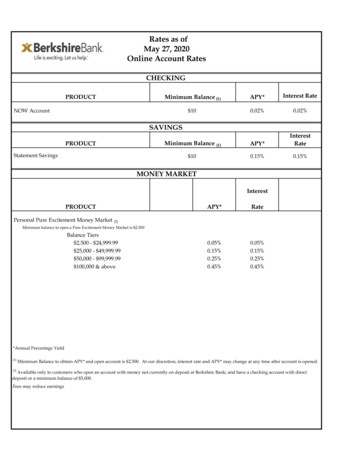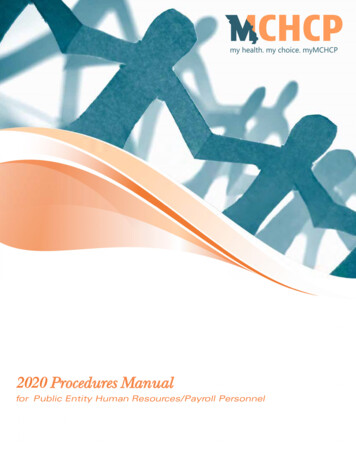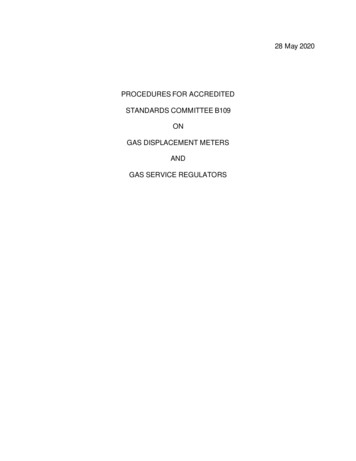
Transcription
28 May 2020PROCEDURES FOR ACCREDITEDSTANDARDS COMMITTEE B109ONGAS DISPLACEMENT METERSANDGAS SERVICE REGULATORS
Table of ContentsProcedures for Accredited Standards Committee B109HISTORY1.0 GENERAL2.0 SCOPE3.0 COMMITTEE3.1 Function3.2 Membership Categories3.3 Officers3.4 Meetings3.5 Voting Procedures3.6 Communications4.0 SUBCOMMITTEE4.1 Organization and Function4.2 Membership4.3 Officers4.4 Meetings4.5 Voting5.0 AD HOC TASK FORCE5.1 Organization and Function5.2 Membership5.3 Voting6.0 SECRETARIAT6.1 Administrative Function6.2 Openness6.3 Committee Membership6.4 Meeting Schedule6.5 Records7.0 REVIEW OF STANDARDS7.1 Revisions of Standards7.2 Reaffirmation of Standards2
7.3 Withdrawal of StandardsTable of Contents (Continued)8.0 DEVELOPMENT OF STANDARDS8.1 Initiation of Standards or Standards Revisions8.2 Distribution for Industry Comment8.3 Consideration of Comments8.4 Committee Action8.5 Submittal to ANSI8.6 Commercial Terms & Conditions8.7 ANSI Patent Policy8.8 Metrics Policy8.9 Interpretations Policy9.0 APPEALS9.1 Complaints9.2 Response9.3 Hearing9.4 Appeals Panel9.5 Conduct of Hearing9.6 Decision10.0 PARLIAMENTARY AUTHORITY3
4
HISTORY OF THE DEVELOPMENT OF STANDARDSFOR GAS DISPLACEMENT METERS AND SERVlCE REGULATORSIn response to an expressed need within the industry for standardization of gasdisplacement meters, the American Gas Association late in 1966 requested theestablishment of a project within the American National Standards Institute (ANSI) fordevelopment of suitable standards for such meters. At a general conference held onJanuary 31, 1967, at ANSI Headquarters, approval of the project scope was obtainedand subsequently endorsed by the Mechanical Standards Board of ANSI.The organizational meeting of ANSI Committee B109 was held on November 30, 1967.The first edition of the Gas Displacement Meter Standard for 500 Cubic Feet per HourCapacity and under (ANSI B109.1-1973) was approved by ANSI on November 27,1973.Subsequently, subcommittees were formed to develop standards for both rotary metersand gas displacement meters with capacities above 500 cubic feet per hour.Concurrently, an addendum for the 1973 standard was developed on "Qualification ofNew Type Meters" and "Test Methods and Equipment."On April 14, 1980, ANSI approved the two new gas displacement standards - ANSIB109.2- 1980 - Diaphragm Type Gas Displacement Meters (over 500 Cubic Feet perHour Capacity) and ANSI B109.3 - 1980 - Rotary Type Gas Displacement Meters. Onthe same date ANSI B109.1a - 1980 Addenda to B109.1-1973 for Gas DisplacementMeters (500 Cubic Feet per Hour Capacity and Under) was approved by ANSI. SecondEditions were approved by ANSI in 1987 and the third Editions in 1992. With the 1992Editions, the titles for B109.1 and BI09.2 were corrected.On November 10, 1992, a revised Committee Scope was approved by ANSI, whichincludes standard coverage for gas service regulators - non-pilot loaded Nominal PipeSize (NPS) 1-1/4 inch and smaller.On April 14, 2008, ANSI approved the reaffirmation of ANSI B109.1, ANSI B109.2,ANSI B109.3, and ANSI B109.4. On January 22, 2010, the Project Initiation NotificationSystem (PINS) for the new BSR B109.0-201x appeared in “Standards Action”. The newperformance-based standard, ANSI B109.0 Natural Gas Meters, under development willapply to all gas meters based on any principle, used to meter the quantity of gas involume, mass or energy units, that has passed through the meter at operating5
conditions. It will apply to gas meters intended to measure quantities of gaseous fuelsor other gases.6
The three displacement meter standards and service regulator standard under B109 areas follows:ANSI BI09.1 Diaphragm type Gas Displacement Meters (under 500 cubic feet per hourcapacity)ANSI BI09.2 Diaphragm type Gas Displacement Meters (500 cubic feet per hourcapacity and over)ANSI B109.3 Rotary type Gas Displacement Meters*ANSI BI09.4 Gas Service Regulators - Non-Pilot loaded, Nominal Pipe Size (NPS) 11/4 inch and smaller*On November 10, 1992, ANSI approved a revised scope which includes gas serviceregulators.7
PROCEDURES FOR ACCREDITED STANDARDS COMMITTEE B1091.0 GENERALThe procedures contained herein set forth the scope of Accredited StandardsCommittee B109 (Committee) and the methods by which evidence of consensus isdeveloped and due process provided during the development of proposed standards forsubmittal to the American National Standards Institute (ANSI) for recognition asAmerican National Standards. ANSI may audit the records of the Committee forcompliance with the ANSI procedures for accredited standards committees.All consensus requirements (public review/voting/consideration of views andobjections/appeals/etc.) apply to new standards, as well as to revisions, reaffirmationsand the withdrawal of standards.2.0 SCOPEAccredited Standards Committee B109 is responsible for the development of standardsfor gas displacement meters, gas service regulators and related devices. Standardsapply to establishing acceptable performance criteria for diaphragm and rotary typedisplacement meters designed for revenue measurement of fuel gas and for gas serviceregulators. Standards include definitions, construction, performance of both new typesand newly constructed meters and service regulators, in-service performance,installation requirements and practices, test methods and equipment.3.0 COMMITTEEIn general, any person (organization, company, government, agency, individual, etc.)with a direct and material interest has a right to participate by: a) expressing a positionand its basis, b) having that position considered, and c) having the right to appeal.Prompt consideration shall be given to the written views and objections of allparticipants, including those commenting on the Project Initiation Notification System(PINS) announcement or public comment listing in the Standards Action. Responsesand attempts at resolution shall be provided in writing to the submitter.For the purposes of this document, “Accredited Standards Developer” (ASD) isinterchangeable with “Secretariat”. The ANSI accreditation is jointly held by theSecretariat and the Committee.3.1 Function8
The Committee:3.1.1 Shall exercise general supervision over the initiation, preparation,maintenance and withdrawal of standards within the Committee'sscope;3.1.2 May establish standing technical Subcommittees, as necessary, todraft standards and develop recommendations on standardsmatters;3.1.3 Shall initiate or otherwise approve subcommittee assignments,supervise subcommittee operation and determine the finaldisposition of all draft standards developed;3.1.4 May appoint ad hoc task forces for particular projects and shallsupervise their operation;3.1.5 Shall develop its own procedures; and3.1.6 Shall consider and act on proposals to terminate the Committee,subcommittee and ad hoc task forces.3.2 Membership CategoriesThe membership of the Committee shall be classified from among the followingcategories:a. Producers (e.g. Equipment Manufacturers)b. Users (e.g. Gas Utilities, Consumers, Gas Transmission Companies)c. General Interest (e.g. Individuals, Government, Research Organizations)3.2.1 Requests for membership shall be addressed to the Secretariat,indicating the applicant's direct and material interest in theCommittee's work and stating qualifications and willingness toparticipate actively.3.2.2 Membership shall be subject to approval of the Committee onrecommendation of the Secretariat (see 6.2.2).3.2.3 Applicants not approved for membership by the Committee shall beadvised of the reason for Committee disapproval and advised oftheir right to appeal in writing (see 9.0).3.2.4 Organizations:9
Organizations including government agencies having substantial concernwith and competence in the scope of the Committee shall be eligible formembership on the Committee.3.2.4.1Member organizations shall designate their officialrepresentative(s) to the Committee and may alsodesignate an alternate to the representative.3.2.4.2A single organization may hold more than onemembership if distinct divisions of the organization candemonstrate separate interest. For example, one divisionor operating company of a private corporation may showa producing or selling interest while another may show abuyer/user interest; or a government agency may show abuyer/user interest in one department and a separateregulatory concern in another department.3.2.5 Individuals:Individuals possessing knowledge in the field of the Committee's workshall be eligible for membership in a personal capacity on the Committee.Individual members shall not have alternates.3.2.6 Companies:Individual companies having substantial concern and competence instandards within the scope of the Committee shall be eligible formembership on the Committee when:3.2.6.1No organization exists through which companies canobtain representation or when an organization exists, butthe company is not a member thereof;3.2.6.2The company is a member of an organization whichdeclines Committee membership because standards arenot included in its activities;3.2.6.3An organization is not sufficiently representative of thoseinterested in the project and additional representationmust be sought; or10
3.2.6.4A company is a member of an organization representedon the Committee, but is substantially concerned with thestandards from a point of view not within the scope of theorganized group.3.2.7 Observers (Liaison Members):Individuals and organizations having interest in the Committee's work mayrequest listing on the Committee roster as observers. They may requestmaterial that is distributed to the Committee, subcommittee(s), and taskforce(s) and may comment, but shall have no vote.3.2.8 BalanceTo ensure a substantial balance of interests on the Committee, the ASDshall strive for a goal of balance in accordance with the following:3.2.8.1No single interest category constitutes more than onethird of the membership of a consensus body dealingwith safety-related standards3.2.8.2No single interest category constitutes a majority of themembership of a consensus body dealing with other thansafety-related standardsNo person shall represent more than one organization, either asrepresentative or alternate.The Committee shall approve the classification categories and therationale therefore.3.2.9 Committee Roster:The Committee roster shall be distributed to the Committee at leastannually, and otherwise posted or available upon request, and shallinclude the following:(1)(2)(3)(4)(5)Title of the Committee and its designation;Scope of the Committee;Secretariat organization, with Secretary's name, address;Officers - Chairman and Vice Chairman;Members - name of organization or agency, its representativeand alternate as applicable, addresses, and business affiliation;11
or name, address and business affiliation of individualmember(s);(6) Classification of each member3.3 OfficersCommittee Officers shall include a Chairman and a Secretary and should includea Vice-Chairman.3.3.1 Election of Officers:The Chairman and Vice Chairman shall be elected at a meeting or byballot by a plurality vote of the Committee for terms of three (3) years andshall be eligible for reelection. Each shall serve until a successor iselected and ready to serve. The Vice-Chairman shall carry out theChairman's duties if the Chairman is temporarily unable to serve.3.3.2 Secretary:The Secretary shall be a Secretariat staff member appointed by theSecretariat and shall have no vote.3.4 Meetings.3.4.1 Call of Meetings:Meetings shall be held at the discretion of the Chairman after reviewingthe items of business pending consideration.3.4.2 Quorum:A majority of the membership shall constitute a quorum for the purpose ofconducting business at a meeting.3.4.3 Public Notice:Public notice of meetings of the Committee relating to the development ofstandards shall be published in a medium which will reach personsreasonably expected to have an interest in the standards. This notice shallappear at least two (2) weeks prior to a regularly scheduled meeting. Thenotice shall include the meeting name and the contact information of theSecretariat staff which can provide further information on the meeting oractivity.3.4.4 Openness:12
Meetings shall be open to all interested parties. The public notice ofCommittee meetings may request that interested parties planning toattend the meeting notify the Secretariat in advance of the meeting toensure that adequate meeting facilities are available.3.4.5 Meeting Registration Fee:When appropriate, Committee meeting participation may be accompaniedwith a meeting registration fee to cover meeting costs (e.g., food andbeverage, audiovisual, facility overhead costs, staff travel, etc.).Registration fees will be reasonable and vary depending upon meetinglocation and length.3.5 Voting ProceduresNote: All consensus requirements apply to new standards, revisions,reaffirmations, and withdrawal of standards.3.5.1 General:3.5.1.1Each representative shall exercise his/her votingprivilege. If by ballot (hardcopy or electronic), this shall bewithin prescribed time limits. An alternate's vote shall becounted only if the representative is not at a meeting ordoes not execute his/her ballot.3.5.1.2No person shall cast a vote for more than oneorganization, either as representative or alternate.3.5.1.3The final vote of the Committee on proposed standardsshall be by recorded vote at a meeting, by written ballot(hardcopy or electronic) or a combination thereof. Eachrepresentative entitled to vote shall vote one of thefollowing positions:(1) Affirmative(2) Affirmative with comment(3) Negative, with reasons(4) Abstain, with reasons.3.5.1.4For votes on membership and officer-related issues, theaffirmation/abstain method of voting shall be followed.13
Votes with regard to these issues need not beaccompanied by reasons and need not be resolved orcirculated to the consensu
On April 14, 2008, ANSI approved the reaffirmation of ANSI B109.1, ANSI B109.2, ANSI B109.3, and ANSI B109.4. On January 22, 2010, the Project Initiation Notification System (PINS) for the new BSR B109.0-201x appeared in “Standards Action”. The new performance-based standard, ANSI B109.0 Natural Gas Meters, under development will apply to all gas meters based on any principle, used to
